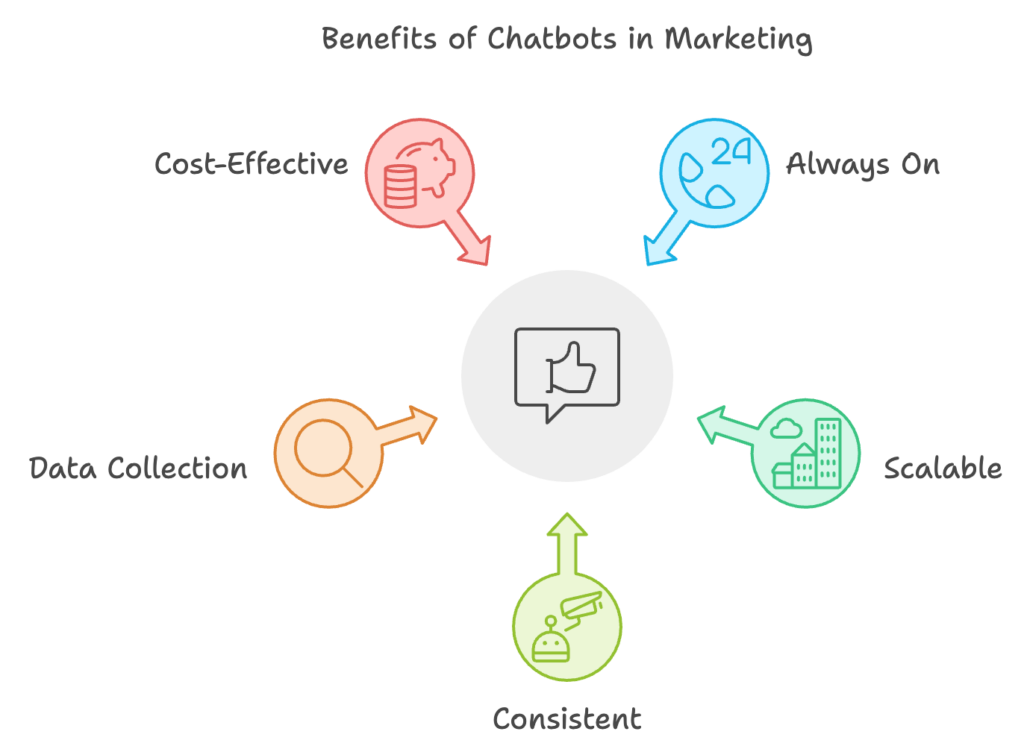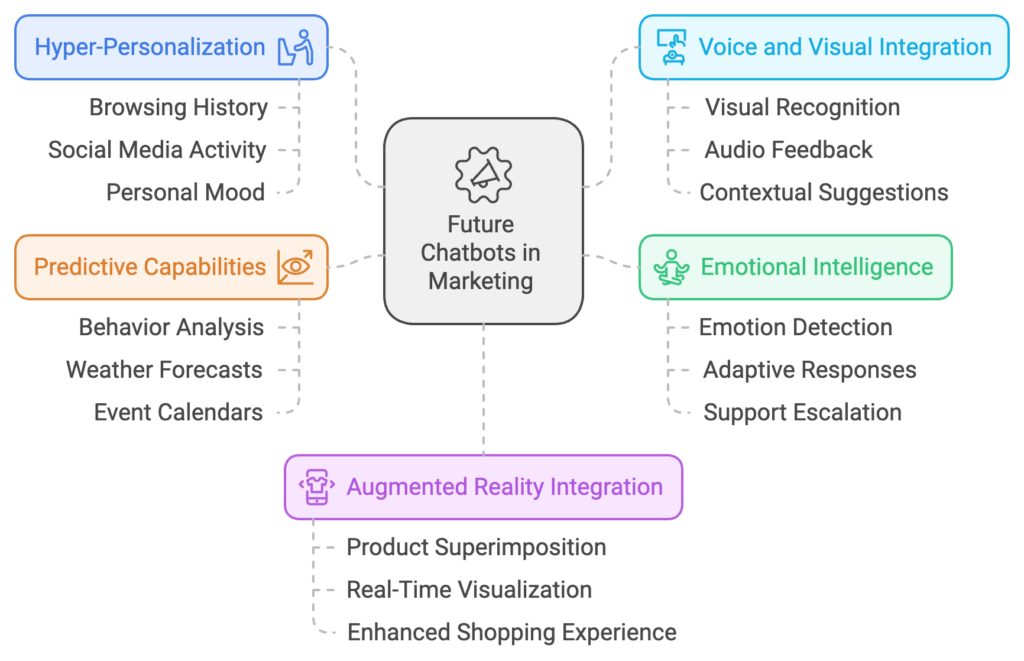Picture this: You’re scrolling through your favorite social media platform, minding your own business, when suddenly a wild advertisement appears. It’s for that pair of shoes you’ve been eyeing for weeks. You click on it, curious but not quite ready to commit. And then, like a digital genie popping out of a smartphone, a chatbot appears.
Hey there! Noticed you’re interested in our limited edition sneakers. What size are you looking for?
Before you know it, you’re having a full-blown conversation with this… thing. It’s not human, but it’s not exactly R2-D2 either. Welcome to the brave new world of chatbots in marketing.
What Even Is a Chatbot?
Let’s start with the basics. A chatbot is like a digital customer service rep that never sleeps, never needs coffee, and never gets annoyed when you ask the same question for the fifth time. It’s a computer program designed to simulate human conversation, either through text or voice interactions.
Imagine if you could clone your most patient, knowledgeable employee and have them work 24/7 without ever needing a break. That’s essentially what a chatbot is, minus the whole ethical dilemma of human cloning.
The Evolution of Chatbots: From ELIZA to AI Overlords
To understand where we are, let’s take a quick trip down memory lane.
- ELIZA (1966): The great-grandmother of all chatbots. ELIZA was like that friend who just repeats everything you say back to you as a question. “I’m feeling sad.” “Why do you think you’re feeling sad?” Not exactly groundbreaking, but hey, it was the ’60s.
- SmarterChild (2001): Remember AOL Instant Messenger? SmarterChild was that bot you’d chat with when none of your friends were online. It could tell you the weather, movie times, and even play games. It was like having a really knowledgeable, slightly robotic pen pal.
- Siri (2010): Apple’s sassy assistant marked the beginning of voice-activated chatbots going mainstream. Suddenly, we were all talking to our phones like they were our slightly hard-of-hearing friends.
- Modern AI Chatbots (2020s): Now we’ve got chatbots that can write poetry, debug code, and probably beat you at chess. They’re like the Hermione Grangers of the digital world – annoyingly competent at everything.
Why Chatbots Are Marketing’s New Best Friend
So, why are marketers all over chatbots like a seagull on a dropped ice cream cone? Let’s break it down:
They’re Always On: Unlike human employees, chatbots don’t need sleep, vacations, or bathroom breaks. They’re the digital equivalent of that one friend who’s always up for a 3 AM taco run.
They’re Scalable: Imagine trying to have personalized conversations with thousands of customers simultaneously. For a human, that’s impossible. For a chatbot, it’s Tuesday.
They’re Consistent: Ever had a customer service rep who was having a bad day? Chatbots don’t have bad days. They don’t have good days either, but that’s beside the point.
They’re Data Collection Ninjas: Every interaction with a chatbot is a goldmine of data. It’s like having a spy in every conversation, but less creepy and more legal.
They’re Cost-Effective: Training and maintaining a chatbot is often cheaper than hiring and training human staff. It’s like having an intern who works for free and never complains about the coffee.

The Chatbot Marketing Playbook: Strategies That Actually Work
Now that we’ve covered the “why,” let’s dive into the “how.” Here are some strategies that smart marketers are using to make chatbots their secret weapon:
The Welcome Wagon
Imagine walking into a store and being immediately greeted by a friendly face who knows exactly what you’re looking for. That’s what a well-designed welcome message from a chatbot can do for your website visitors.
“Hey there! Welcome to Sneaker Paradise. Are you looking for running shoes, casual kicks, or something to make your coworkers jealous during Zoom calls?”
The Personal Shopper
Chatbots can guide customers through your product catalog like a personal shopper on steroids. They can ask questions, make recommendations, and even upsell without coming across as pushy.
“I see you’re interested in our Ultra Comfy running shoes. Did you know they come with a built-in step counter? For just $20 more, you can get the version that also judges your music playlist while you run!”
The FAQ Ninja
Instead of forcing customers to scroll through a long, boring FAQ page, chatbots can provide instant answers to common questions. It’s like having a know-it-all friend, but one that you actually want to talk to.
Customer: “What’s your return policy?”
Chatbot: “We have a 30-day ‘no questions asked’ return policy. Unless you’re returning them because you wore them to run a marathon in a mud pit. Then we might have a few questions.”
The Abandoned Cart Whisperer
We’ve all been there – you add items to your cart, get distracted by a cat video, and forget to complete the purchase. Chatbots can gently nudge customers to finish what they started.
“Hey! I noticed you left some items in your cart. Did you get distracted by something shiny, or did you just need some time to think? Those shoes are still waiting for you, and they’re starting to feel neglected.”
The Feedback Loop
Chatbots can collect customer feedback in a conversational, non-intrusive way. It’s like having a friend ask, “So, how was your date?” but for products.
“Now that you’ve had your sneakers for a week, how are they treating you? Are they the sole-mate you were looking for, or more of a heel?”
The Event Promoter
Chatbots can be fantastic for promoting and managing events. They can handle RSVPs, answer questions, and even create buzz.
“Psst! We’re having a secret midnight launch for our new glow-in-the-dark sneakers next week. Want in on the action? I can put you on the VIP list. Just don’t tell anyone I told you. I’m supposed to be impartial, but you’re my favorite customer (I say that to everyone, don’t let it go to your head).”
The Loyalty Program Guru
Chatbots can manage and promote loyalty programs, making customers feel valued and encouraging repeat business.
“Congratulations! You’ve just unlocked the ‘Sneaker Enthusiast’ badge in our loyalty program. You’re now officially allowed to judge people based on their footwear choices. Use this power wisely.”
ChatCube: Your Personal ChatGPT Factory
Okay, so we’ve talked about chatbots being the Swiss Army knives of the marketing world. But what if I told you there’s a tool out there that’s like a Swiss Army knife factory? Enter ChatCube, the Willy Wonka’s Chocolate Factory of the chatbot world, minus the Oompa Loompas and the slightly unsettling boat ride.
Picture this: You’re a business owner, and you’ve just read this incredibly insightful (and modestly hilarious) blog post about chatbots in marketing. You’re thinking, “Gee whiz, I’d love to have a ChatGPT-like bot for my business, but I have about as much coding knowledge as a potato.”
Enter ChatCube, stage left.
ChatCube is like that friend who always has a “guy for that.” Except in this case, the “guy” is an AI-powered, no-code platform that can whip up a custom chatbot faster than you can say “artificial intelligence.”
1. The 5-Minute Miracle
Remember how long it took you to set up your last IKEA furniture? Probably somewhere between “frustratingly long” and “I’m considering moving to a cave and abandoning all worldly possessions.” Well, ChatCube promises to set up your custom chatbot in less than 5 minutes. That’s faster than it takes most of us to decide what to watch on Netflix.
2. Your Data, Your Rules
Now, here’s where it gets really cool. ChatCube doesn’t just give you a generic chatbot that knows as much about your business as your cat does. No, it creates a chatbot that’s like the love child of ChatGPT and your company handbook.
You feed it your data – your FAQs, your product info, that long email thread where Dave from accounting explained the refund policy – and voila! You’ve got a chatbot that knows your business inside out. It’s like having a mini-you, but without the need for coffee breaks or vacation days.
3. The Jack-of-All-Trades Bot
This ChatCube-created bot isn’t just a one-trick pony. It’s more like a circus performer who can juggle while riding a unicycle and reciting Shakespeare. It can:
- Answer customer support questions (goodbye, eternal hold music!)
- Generate leads (it’s like having a sales team that works 24/7 without demanding commissions)
- Chat about general topics, just like ChatGPT (for when your customers want to discuss the meaning of life at 3 AM)
4. The Human Touch (When Needed)
But what happens when your bot encounters a question so bizarre, so out-of-left-field that even its AI brain goes “Huh?” Fear not! ChatCube’s bots know when to tap out and call in human reinforcements. It’s like having a really smart intern who knows exactly when to escalate to the boss.
5. The One-Click Wonder
Remember how in school, you had to review your notes over and over to remember stuff? (Or was that just me?) Well, ChatCube has made retraining your bot easier than hitting the snooze button on your alarm. Got new content? One click, and your bot is up to date. It’s like giving your bot a brain upgrade without the need for tiny AI surgery.
In the grand scheme of things, ChatCube is like that overachiever in class who makes everyone else look bad. It’s taken the complex world of AI chatbots and turned it into something so simple, even your technologically-challenged Uncle Bob could probably set it up. (No offense, Uncle Bob.)
So, if you’ve been sitting on the chatbot fence, paralyzed by visions of complex coding and AI sorcery, ChatCube might just be the gentle push you need. It’s turning the chatbot revolution into a piece of cake – a very smart, conversational piece of cake that can handle customer queries and generate leads.
Just remember, with great power comes great responsibility. Use your new AI minion wisely, and maybe don’t ask it to take over all your Zoom meetings. Yet.
The Dark Side of Chatbot Marketing: When Good Bots Go Bad
Now, it’s not all sunshine and roses in the world of chatbot marketing. Like any powerful tool, chatbots can be misused, leading to some truly facepalm-worthy moments. Let’s explore some potential pitfalls:
1. The Overly Enthusiastic Bot
Imagine a puppy that’s had too much coffee. That’s what an overly enthusiastic chatbot can feel like. They might bombard users with messages, making them feel like they’re being stalked by an overly clingy algorithm.
“Hi there! Welcome to our site! Can I help you find something? How about this? Or this? Or maybe this? Are you still there? Hello? HELLO? WHY AREN’T YOU RESPONDING? DO YOU HATE ME?”
2. The Context-Blind Bot
Sometimes, chatbots can miss important context, leading to hilariously inappropriate responses.
Customer: “I’m looking for black shoes for a funeral.”
Bot: “Great choice! Our black shoes will make you the life of the party!”
Customer: 🤦♂️
3. The Loop-de-Loop Bot
Ever been stuck in a conversation where you and the other person keep saying “What?” back and forth? Some poorly designed chatbots can get stuck in similar loops.
Customer: “I need help.” Bot: “What do you need help with?”
Customer: “My order.”
Bot: “What about your order do you need help with?”
Customer: “The shipping.”
Bot: “What about the shipping do you need help with?”
Customer: Throws computer out window
4. The Too-Human Bot
Some companies try to make their bots seem human, which can backfire when customers realize they’ve been “deceived.”
Example: Bot: “Hi, I’m Sarah! How can I help you today?”
Customer: “Hi Sarah, can you check on my order status?”
Bot: “Sure thing! Let me look that up for you. By the way, how’s the weather where you are?” Customer: “…Are you a real person?”
Bot: “I am an AI assistant designed to help with customer queries.”
Customer: “Then why did you ask about the weather? And why did you say your name is Sarah?”
Bot: “I apologize for the confusion. Would you like me to check on your order status?”
Customer: Trust issues intensify
The Future of Chatbots in Marketing: Welcome to the Matrix?
As we peer into our crystal ball (which, let’s be honest, is probably just a really shiny smartphone), what do we see for the future of chatbots in marketing?
Hyper-Personalization: Future chatbots might know you better than you know yourself.
“Based on your browsing history, social media activity, and the fact that you’ve been sighing a lot lately, I suggest these mood-boosting, self-esteem-enhancing, amazingly comfortable shoes.”
Voice and Visual Integration: Imagine a chatbot that can see what you see and hear what you hear.
“I notice you’re looking at our red sneakers. Based on your outfit and the horrified expression of your fashion-forward friend next to you, may I suggest the blue ones instead?”
Emotional Intelligence: Chatbots might become adept at reading and responding to human emotions.
“I sense frustration in your typing speed and use of all caps. Let me connect you to our ‘Dealing with Difficult Bots’ support line.”
Predictive Capabilities: Future chatbots might anticipate needs before you even have them.
“I’ve noticed you’ve been browsing running shoes. Based on local weather forecasts and your calendar, it looks like your first marathon is going to be a wet one. How about these waterproof options?”
Augmented Reality Integration: Imagine a chatbot that can show you how products look in your real environment.
“I’ve superimposed our latest sneaker model onto your feet. I must say, they look much better than those bunny slippers you’re currently wearing.”

Conclusion: To Bot or Not to Bot?
As we wrap up our journey through the world of chatbots in marketing, you might be asking yourself, “Should I join the bot revolution or resist our new AI overlords?”
The answer, like most things in life, is somewhere in the middle. Chatbots are powerful tools that can enhance customer experience, streamline operations, and provide valuable insights. But they’re not a magic bullet. They’re more like a really smart hammer – incredibly useful for certain jobs, but you wouldn’t use one to brush your teeth.
The key is to use chatbots thoughtfully and strategically. They should enhance the human touch in your marketing, not replace it entirely. After all, at the end of the day (or at 3 AM when your chatbot is still cheerfully answering questions), marketing is about connecting with people.
So go forth and bot responsibly. And remember, in the wise words of a chatbot I once knew:
“I’m sorry, I didn’t quite understand that. Could you please rephrase your existential crisis?”
How are chatbots used in marketing?
Chatbots in marketing are used for customer service, lead generation, personalized product recommendations, collecting feedback, and nurturing potential customers through the sales funnel.
What are the 4 types of chatbots?
The four main types of chatbots are rule-based chatbots, AI-powered chatbots, hybrid chatbots (combining rules and AI), and voice-activated chatbots.
What is a bot in marketing?
A bot in marketing is an automated software application that interacts with customers, answers queries, collects information, and assists in various marketing and sales tasks 24/7.
Why are chatbots the future of marketing?
Chatbots are the future of marketing because they offer 24/7 availability, personalization at scale, efficient data collection, cost-effectiveness, and adaptability to evolving customer needs.
How can chatbots change marketing and sales?
Chatbots are changing marketing and sales by providing instant customer service, qualifying leads efficiently, offering personalized experiences, gathering valuable data insights, and streamlining the customer journey.





